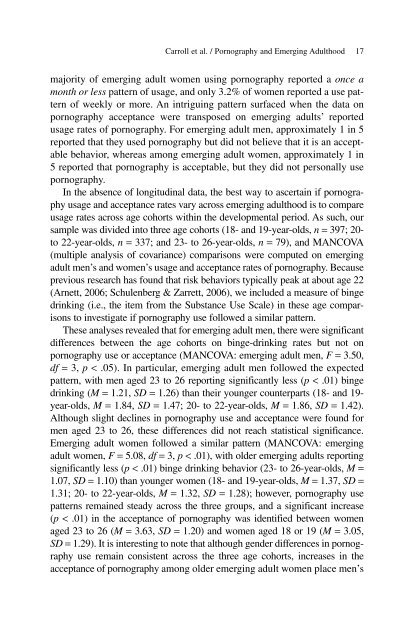Generation XXX
Generation XXX
Generation XXX
Create successful ePaper yourself
Turn your PDF publications into a flip-book with our unique Google optimized e-Paper software.
Carroll et al. / Pornography and Emerging Adulthood 17<br />
majority of emerging adult women using pornography reported a once a<br />
month or less pattern of usage, and only 3.2% of women reported a use pattern<br />
of weekly or more. An intriguing pattern surfaced when the data on<br />
pornography acceptance were transposed on emerging adults’ reported<br />
usage rates of pornography. For emerging adult men, approximately 1 in 5<br />
reported that they used pornography but did not believe that it is an acceptable<br />
behavior, whereas among emerging adult women, approximately 1 in<br />
5 reported that pornography is acceptable, but they did not personally use<br />
pornography.<br />
In the absence of longitudinal data, the best way to ascertain if pornography<br />
usage and acceptance rates vary across emerging adulthood is to compare<br />
usage rates across age cohorts within the developmental period. As such, our<br />
sample was divided into three age cohorts (18- and 19-year-olds, n = 397; 20to<br />
22-year-olds, n = 337; and 23- to 26-year-olds, n = 79), and MANCOVA<br />
(multiple analysis of covariance) comparisons were computed on emerging<br />
adult men’s and women’s usage and acceptance rates of pornography. Because<br />
previous research has found that risk behaviors typically peak at about age 22<br />
(Arnett, 2006; Schulenberg & Zarrett, 2006), we included a measure of binge<br />
drinking (i.e., the item from the Substance Use Scale) in these age comparisons<br />
to investigate if pornography use followed a similar pattern.<br />
These analyses revealed that for emerging adult men, there were significant<br />
differences between the age cohorts on binge-drinking rates but not on<br />
pornography use or acceptance (MANCOVA: emerging adult men, F = 3.50,<br />
df = 3, p < .05). In particular, emerging adult men followed the expected<br />
pattern, with men aged 23 to 26 reporting significantly less (p < .01) binge<br />
drinking (M = 1.21, SD = 1.26) than their younger counterparts (18- and 19year-olds,<br />
M = 1.84, SD = 1.47; 20- to 22-year-olds, M = 1.86, SD = 1.42).<br />
Although slight declines in pornography use and acceptance were found for<br />
men aged 23 to 26, these differences did not reach statistical significance.<br />
Emerging adult women followed a similar pattern (MANCOVA: emerging<br />
adult women, F = 5.08, df = 3, p < .01), with older emerging adults reporting<br />
significantly less (p < .01) binge drinking behavior (23- to 26-year-olds, M =<br />
1.07, SD = 1.10) than younger women (18- and 19-year-olds, M = 1.37, SD =<br />
1.31; 20- to 22-year-olds, M = 1.32, SD = 1.28); however, pornography use<br />
patterns remained steady across the three groups, and a significant increase<br />
(p < .01) in the acceptance of pornography was identified between women<br />
aged 23 to 26 (M = 3.63, SD = 1.20) and women aged 18 or 19 (M = 3.05,<br />
SD = 1.29). It is interesting to note that although gender differences in pornography<br />
use remain consistent across the three age cohorts, increases in the<br />
acceptance of pornography among older emerging adult women place men’s
















